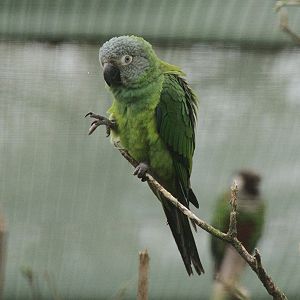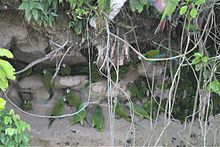- Dusky-headed Parakeet
-
Dusky-headed Parakeet 
At Beale Park, Reading, Berkshire, England Conservation status Scientific classification Kingdom: Animalia Phylum: Chordata Class: Aves Order: Psittaciformes Family: Psittacidae Genus: Aratinga Species: A. weddellii Binomial name Aratinga weddellii
(Deville, 1851)The Dusky-headed Parakeet (Aratinga weddellii), also known as the or Weddell's Conure or Dusky-headed Conure in aviculture, is a species of parrot found in wooded habitats in the western Amazon Basin. It prefers semi-open habitats such as várzea, forest edge and forest remnants, but can also be found in coffee plantations. It is generally common and its habitat preference makes it less vulnerable than many other Amazonian species. Consequently, it is considered to be of least concern by BirdLife International and IUCN.
This long-tailed species is generally green in color (both lutino and blue mutations are rare, but do exist in captivity) with a gray-brown head, a blue-tipped tail and remiges that are dark gray from below, mainly blue from above. The bill is black, and it has a broad bare white (sometimes yellow-tinged) eye-ring. With an average length of 25–28 cm (10–11 in) and a weight of about 100 grams, it is slightly smaller than the Sun Conure.
It is social, and usually found in pairs or small groups. When food is plentiful, it may form flocks of up to 100 members. It eats fruit, seeds, and flowers, and will search decaying wood for insect larvae. It also ingests mineral-rich soil, e.g. from a clay lick, as a supplement. The pair raise their offspring together, nesting in woodpecker holes in trees or arboreal termite nests.
They do well in captivity.[citation needed] They are fairly easy to breed if provided with a durable nest box, and will lay up to three clutches per year.[citation needed] They are known to be quiet, compared to other conure species, but still very energetic and clownish, like most conures.[citation needed]
References
- Juniper, T.; Parr, M. (1998). A Guide to the Parrots of the World. East Sussex: Pica Press. ISBN 1-873403-40-2.
- BirdLife International (2008). Aratinga weddellii. In: IUCN 2008. IUCN Red List of Threatened Species. Downloaded on 17 November 2008. Database entry includes a brief justification of why this species is near threatened.
External links
- "Dusky-headed Parakeet - BirdLife Species Factsheet". BirdLife International (2008). http://www.birdlife.org/datazone/species/index.html?action=SpcHTMDetails.asp&sid=1575&m=0. Retrieved 3 January 2009.

This article relating to parrots is a stub. You can help Wikipedia by expanding it.


